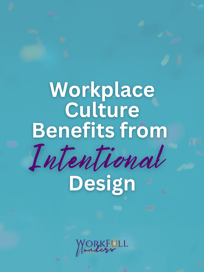Workplace Culture Benefits from Intentional Design
Jeannine Herrick
9/17/2023


Intentional Design of Workplace Culture – A Strategic Imperative
The modern landscape of modern work looks and feels a lot different than just a few years ago wouldn’t you say? The shifts to remote and hybrid options, the entrance of AI into our workflows, and generational shifts in preferences and expectations related to work norms means we need to take a closer look at what each workplace, each team and each employee needs to be successful.
It's crucial to recognize that workplace culture is not a passive outcome but a strategic asset that requires INTENTIONAL design.
Here are some benefits from taking a more intentional approach:
1. Alignment with Organizational Goals
What would it be like if every staff member felt connected to and motivated by the goals of the overall organization? This is every senior leader’s dream because this is how you ideally move a group towards collective wins.
When you apply some design practices to how workplace culture comes to life it provides an important opportunity to ensure the overall vibe is in alignment with the company's mission, vision, and values. When culture is deliberately crafted to reflect these fundamental aspects, it becomes a driving force that propels the organization forward in a cohesive and purposeful manner.
2. Attracting and Retaining Top Talent
A well-designed workplace culture acts as a powerful magnet for talent. Prospective employees are drawn to organizations with values and a culture that resonate with their own beliefs and aspirations. Communications related to recruitment should lead with what it feels like to work at a given workplace and how working there is tied to a larger purpose. It sends a direct message to exceptional candidates who feel an immediate connection. The best talent is motivated by how they contribute to a larger purpose versus individual gains. A curated culture conveys a commitment to intentionality and that will speak volumes to strong potential staff members.
Similarly, a positive culture is the number one factor in retaining existing talent, reducing turnover rates, and fostering a sense of belonging and dedication. When people feel that their effort is valued AND they feel connected to their colleagues as well as a collective purpose they typically want to stay and continue to contribute at a high level.
3. Enhanced Productivity and Employee Engagement
An intentionally designed workplace culture has a direct impact on employee engagement and productivity. A culture that encourages collaboration, innovation, and inclusivity motivates employees to give their best and feel valued within the organization. Makes sense right? The hard part is knowing how to encourage these things… what strategies really work. Rest assured- there are proven methods to get people working together better, to stimulate new ideas and for helping everyone feel like they belong. When effort is invested in these areas…. everything else goes more smoothly.
4. Improved Morale and Well-Being
By consciously crafting a culture that prioritizes employee well-being, mental health, and work-life balance, companies can boost morale and create a supportive environment. When employees feel cared for, they are more likely to perform at their peak and contribute positively to the workplace.
The biggest mistake leaders make in approaching enhancing morale and well-being is to offer one-off opportunities. This must be an integrated approach that seeps into the very foundations and everyday experiences. And that… takes intentional effort.
5. Adaptability and Resilience
A carefully designed workplace culture can instill adaptability and resilience in the face of change. In a fast-evolving landscape, a strong culture ensures that employees remain aligned with the organization's values, even during challenging times. Strong culture also fosters stability and unity.
We often get asked to help teams and organizations be more adaptable and more resilient. What we have learned is that any efforts in these areas must start and end focused on the internal culture. If staff consistently need support in these areas, chances are the culture needs some refinement, so people feel safe making mistakes.
6. Mitigating Legal and Ethical Risks
Proactively shaping workplace culture allows companies to establish clear guidelines and expectations, reducing the likelihood of legal and ethical issues. A well-defined culture promotes adherence to legal compliance and ethical standards, safeguarding the company's reputation and minimizing legal risks. In essence, people who are invested in the success of their team and overall organization are going to minimize risk and act in ways that protect the integrity of the work itself.
The importance of internal culture cannot be overstated. Workplace culture really is a strategic imperative. The benefits range from helping leaders and staff aligning with organizational goals, attracting and retaining top talent, and indirectly improving staff productivity, well-being, and adaptability. By recognizing the POWER of intentional culture design, leaders can drive their organizations toward sustainable success and growth.


